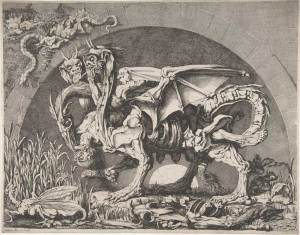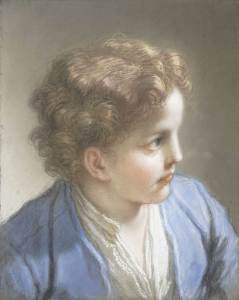‘Spontaneity, experimentation and whimsy’ are the three words used to introduce one of two exhibitions that have opened this season at the Metropolitan Museum of Art in New York. ‘Artists and Amateurs: Etching in Eighteenth-Century France’ and ‘Eighteenth-Century Pastels’ both showcase works in those media from the Met alongside loaned works from public and private collections. Likewise, the Morgan Library in New York is showing ‘Tiepolo, Guardi, and their World: Eighteenth-Century Venetian Drawings’ from its own collections, and the Huntington Library in Pasadena has ‘Illuminated Palaces: Extra-Illustrated Books from the Huntington Library’.
In London, tours and events themed around the 18th century happen weekly, and the British Library is showing ‘Georgians Revealed: Life, Style and the Making of Modern Britain’. The 18th century is so hot right now. But why?

The Chimera (before 1771), Louis-Jean Desprez The Metropolitan Museum of Art, Purchase, 1998
I think that the Met’s three opening words, and their two shows as exemplars, give us a clue. Both are richly textured and vibrant in both image and content. ‘Amateurs and Artists’ explores how artists and collectors together formed a special place for etching in France. Some names crop up here that we would expect – Watteau, Boucher, Fragonard – but also less expected ones like marine painter Joseph Vernet or the polymath Baron Dominique Vivant Denon, printmaker, diplomat, writer and archaeologist.
Images include the experimental dark and sombre aquatints of Louis-Jean Desprez alongside the delightfully whimsical La Toilette of Charles Germain de Saint Aubin, featuring butterflies engaged in human activities. Prints by Joseph Marie Vien and Jean-Baptiste Marie Pierre show student etchers from the Académie de France in Rome, enjoying themselves riotously in Chinese or Turkish carnival costumes.
‘Eighteenth-Century Pastels’ showcases what the Met text so aptly describes as their ‘distinctive velvety quality’. Most are portraits, where the beautiful delineation of the costumes vies with the enigmatic and winning expressions captured in their owners’ faces; but there are also three unusual maritime and landscape scenes by Jean Pillement. The portraits come from French, British, Italian, Danish and German crayons, with a particularly striking and rare example in grisaille by Joseph Wright of Derby. This merges the velvet surface with the expressive lines of the etchings.

Study of a Boy in a Blue Jacket (1717), Benedetto Luti The Metropolitan Museum of Art, Gwynne Andrews Fund, 2007
Both shows noticeably feature female artists. Among the etchers we meet both Marguerite Gérard, sister-in-law and student of Fragonard, and Marguerite le Comte, mistress of Claude Henri Watelet. Both are lauded for their talents individually and in collaboration with these men. Adélaïde Labille-Guiard takes the stage in ‘Eighteenth-Century Pastels’, remarkable for her ability to capture sitters’ moods.
Both exhibitions present us with a visually beautiful period, represented through rich and complex media. The images are peopled with vibrant and whimsical people who excel at both the elegant and risqué sides of life, who display views and concerns that we would echo or at least like to hear. We see learning and skill combined with joy in experiment, humour and frisson. In appreciating the 18th century, we enjoy a view of a world which we would like to be our own.
‘Eighteenth-Century Pastels’ and ‘Artists and Amateurs: Etching in Eighteenth-Century France’ are on at the Metropolitan Museum of Art until 29 December 2013 and 5 January 2014 respectively.

18th-century Envy
Study of a Boy in a Blue Jacket (1717), Benedetto Luti The Metropolitan Museum of Art, Gwynne Andrews Fund, 2007
Share
‘Spontaneity, experimentation and whimsy’ are the three words used to introduce one of two exhibitions that have opened this season at the Metropolitan Museum of Art in New York. ‘Artists and Amateurs: Etching in Eighteenth-Century France’ and ‘Eighteenth-Century Pastels’ both showcase works in those media from the Met alongside loaned works from public and private collections. Likewise, the Morgan Library in New York is showing ‘Tiepolo, Guardi, and their World: Eighteenth-Century Venetian Drawings’ from its own collections, and the Huntington Library in Pasadena has ‘Illuminated Palaces: Extra-Illustrated Books from the Huntington Library’.
In London, tours and events themed around the 18th century happen weekly, and the British Library is showing ‘Georgians Revealed: Life, Style and the Making of Modern Britain’. The 18th century is so hot right now. But why?
The Chimera (before 1771), Louis-Jean Desprez The Metropolitan Museum of Art, Purchase, 1998
I think that the Met’s three opening words, and their two shows as exemplars, give us a clue. Both are richly textured and vibrant in both image and content. ‘Amateurs and Artists’ explores how artists and collectors together formed a special place for etching in France. Some names crop up here that we would expect – Watteau, Boucher, Fragonard – but also less expected ones like marine painter Joseph Vernet or the polymath Baron Dominique Vivant Denon, printmaker, diplomat, writer and archaeologist.
Images include the experimental dark and sombre aquatints of Louis-Jean Desprez alongside the delightfully whimsical La Toilette of Charles Germain de Saint Aubin, featuring butterflies engaged in human activities. Prints by Joseph Marie Vien and Jean-Baptiste Marie Pierre show student etchers from the Académie de France in Rome, enjoying themselves riotously in Chinese or Turkish carnival costumes.
‘Eighteenth-Century Pastels’ showcases what the Met text so aptly describes as their ‘distinctive velvety quality’. Most are portraits, where the beautiful delineation of the costumes vies with the enigmatic and winning expressions captured in their owners’ faces; but there are also three unusual maritime and landscape scenes by Jean Pillement. The portraits come from French, British, Italian, Danish and German crayons, with a particularly striking and rare example in grisaille by Joseph Wright of Derby. This merges the velvet surface with the expressive lines of the etchings.
Study of a Boy in a Blue Jacket (1717), Benedetto Luti The Metropolitan Museum of Art, Gwynne Andrews Fund, 2007
Both shows noticeably feature female artists. Among the etchers we meet both Marguerite Gérard, sister-in-law and student of Fragonard, and Marguerite le Comte, mistress of Claude Henri Watelet. Both are lauded for their talents individually and in collaboration with these men. Adélaïde Labille-Guiard takes the stage in ‘Eighteenth-Century Pastels’, remarkable for her ability to capture sitters’ moods.
Both exhibitions present us with a visually beautiful period, represented through rich and complex media. The images are peopled with vibrant and whimsical people who excel at both the elegant and risqué sides of life, who display views and concerns that we would echo or at least like to hear. We see learning and skill combined with joy in experiment, humour and frisson. In appreciating the 18th century, we enjoy a view of a world which we would like to be our own.
‘Eighteenth-Century Pastels’ and ‘Artists and Amateurs: Etching in Eighteenth-Century France’ are on at the Metropolitan Museum of Art until 29 December 2013 and 5 January 2014 respectively.
Unlimited access from just $16 every 3 months
Subscribe to get unlimited and exclusive access to the top art stories, interviews and exhibition reviews.
Share
Recommended for you
First Look: Facing the Modern
Gemma Blackshaw, guest curator of ‘Facing the Modern: the Portrait in Vienna 1900’ at the National Gallery in London, speaks to Apollo
Fashion Victim
An exhibition of Robert Mapplethorpe’s fashion photography proves that he was at his best focusing on the nude
Acme Corporation
The Whitechapel Gallery celebrates Acme Studios’ avant-garde roots, but is it now just urban ruin-porn for London’s property developers?